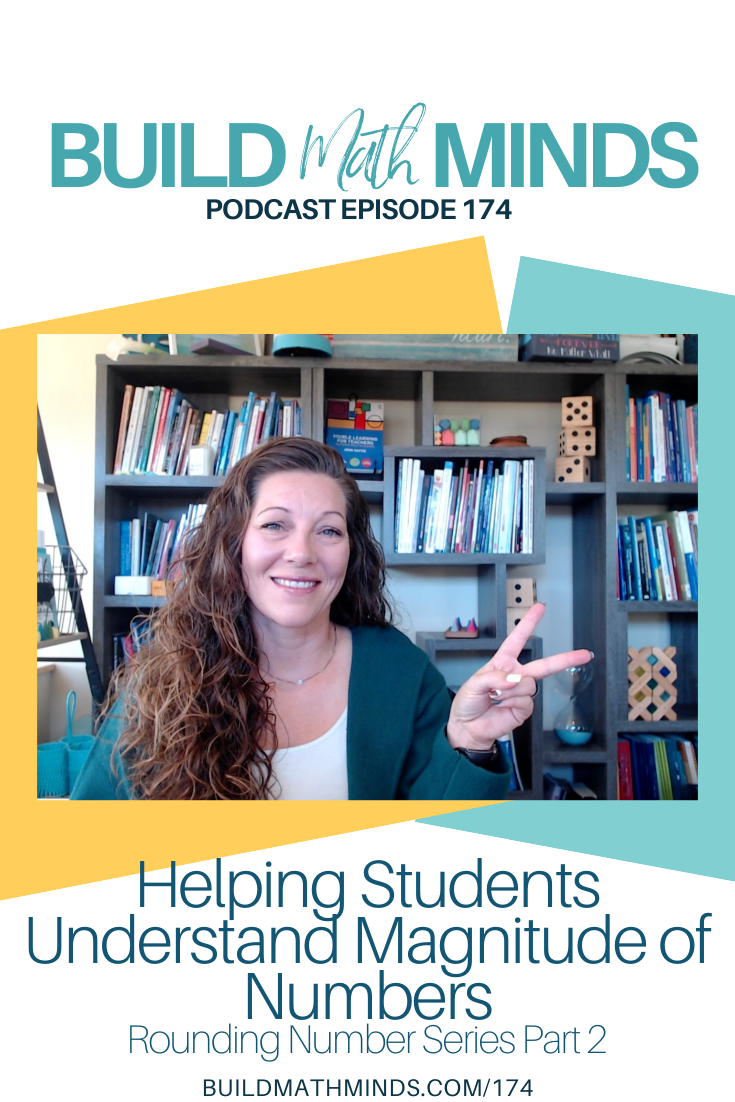Welcome fellow Recovering Traditionalists to Episode 174: Helping Students Understand Magnitude of Numbers – Rounding Numbers Series
I got a question sent in to me and because it deserves more than a short answer, I’m doing three episodes to answer it. Here is what was sent in: “Some of my kiddos have trouble telling me which tens a number is between. For example, I’ll give them 53 and ask them to round it, but they can’t say it’s between either 50 or 60.”
This is actually very common and is rooted in the fact that kids are seeing numbers in isolation and haven’t built relationships around numbers. We can’t jump into rounding if students haven’t spent time exploring how numbers relate to each other because that’s all that rounding really is.
Rounding is usually taught as a Place Value concept where you teach kids the procedure of looking at the digit in the specified place but as I discussed in the last episode, as Recovering Traditionalists we instead should be helping students build their number sense and when students have number sense they naturally see what numbers are closest to for rounding.
Last week I gave you my first tip for helping your students with rounding and that was to do lots of work with number lines and number paths. If you missed that episode, go back and listen to it…it was number 173.
My second tip for helping your students with rounding and being able to know what numbers a specific number is close to is to do lots of work helping them understand the magnitude of a number.
Now technically the magnitude of a number is that number’s distance to zero. However, we use that understanding to compare numbers. It is basically the property of numbers that we use when ordering or ranking numbers.
Any time you are doing activities where students are comparing quantities you are helping them work on understanding the magnitude of numbers. Having students place numbers on number lines helps solidify the idea that we are looking at how far away a number is from zero and the farther away it is, the larger its magnitude.
So that’s why my first tip was to have students get comfortable with using number lines and placing numbers on a number line because then they can use that visual of numbers on the number line to help them do any activity that asks them to compare numbers.
One of my favorite activities is a routine called Close, Far, In-between. It not only focuses on magnitude, but also estimation and reasoning. Close, Far, In-between first appeared in the book “Mathematics Their Way” by Mary Baratta-Lorton and I just love it for all the different types of questions you can ask students beyond just the typical “which amount is greater?” when comparing numbers.
Inside the Build Math Minds PD site we have a document with over 120 pre-made Close, Far, In-between routines. So I’m going to show you this one example from that document:

For those listening all you have to do for the routine is have three quantities, in this example we have 464, 319, and 557. This routine isn’t about having the students put them in order. Typically, during the routine you just ask simple questions like “Which of these numbers are closest to each other?” “Which number is in-between the other two numbers?” “Which two numbers are the farthest away from each other?” and those three questions are fabulous questions that will help your students estimate, reason, and build their understanding of the magnitude of the numbers.
But if you’d like you can extend this into even more areas. Here’s a screenshot of the notes that go with the slides inside the routine we created for our Build Math Minds members of just some of the questions they could ask:

I know this routine isn’t actually doing any rounding, but remember we are focusing on helping students build a sense of numbers and how numbers relate to each other. Rounding is all about knowing what ‘friendly numbers” a number is close to and when students are doing this routine you will hear them often comparing the numbers given to those friendly numbers. You will hear things like “557, that’s close to 550 so….” Plus I highly suggest having students visualize these numbers on a number line (or even draw it) because the more work they have with number lines the better.
If you are a member of the Build Math Minds PD site, you have access to this Close, Far, In-between document and so much more to help you build these ideas with your students. If you aren’t a member, go over to BuildMathMinds.com/BMM to join.
This routine isn’t just for whole numbers or even multi-digit numbers. We should be doing it with young students, like this example in our document that is showing finger patterns instead of numerals. We should also be doing this as students are working on operations and as they move into decimals & fractions. As I said before, the document we have for our Build Math Minds PD site members has over 120 pre-made slides that are for all ages and you can easily swap out numbers to use the slides over and over again with different numbers inside the circles.
If you aren’t a member, tomorrow just put three quantities on the board and start asking questions that dig into what is Close, Far, and In-between.
I hope this helped build your math mind so you can build the math minds of your students. See you next week.




